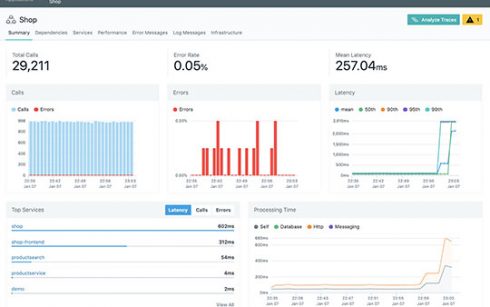
There is no one-size-fits-all approach when it comes to successfully implementing DevOps, but there are some concrete methods you need in place to help get you there. The “2019 Accelerate State of DevOps” report found that efforts like automation and monitoring can help organizations improve the speed of software delivery and create value.
“For example, teams can monitor their own code, but will not see full benefits if both application and infrastructure are not monitored and used to make decisions,” the report stated.
Kevin Crawley, DevOps evangelist for the APM company Instana, added that deployment frequency, lead time for changes, time to restore services, and change fail rate are leading indicators of how mature a given company’s software development life cycle is.
Crawley explained that successful CI/CD or DevOps cannot happen if there is not monitoring and observability in place. Without it, rapid introduction of performance problems and errors, new endpoints causing monitoring issues, and lengthy root cause analysis will occur as the number of services expand.
“In order to successfully have a true continuous integration pipeline where you are continuously deploying changes, you have to have solid monitoring around those systems so you can understand when you do push a change that does break something, you have immediate feedback,” he said in a recent webinar.
The problem is that most traditional monitoring tools require manual efforts for many tasks such as:
- writing and configuring data collectors
- instrumenting code for tracing
- discovering dependencies
- deciding how to create data
- building dashboards to visualize correlation
- configuring alerting rules and thresholds
- building data collection to store metrics
All of this can be quite a bit of work and very time-consuming, Crawley explained. The loop of CI/CD and DevOps is a never-ending delivery process and any manual steps will slow teams down.
“Without monitoring, the SRE or DevOps teams really have no visibility into operations and how the application is performing in production,” he said. “In this world where we talk about continuous integration and continuous deployments, manual steps really prevent the velocity and the speed that your organization needs to get software out the door.”
When evaluating how an organization’s monitoring solutions are working for them, some of the questions they need to ask themselves are, how many services are they capable of monitoring and what are they collecting from that monitoring?
“There are a lot of questions we can ask here that will give you an idea of how much value Instana can bring to your operation teams,” he added. “How much effort are the engineers spending to build this visibility and if you are using an APM tool, what are you using and does it help you automate some of these steps.”
Crawley went on to say “If you don’t have automation in your monitoring, you likely won’t have good visibility, and therefore you won’t have the velocity needed to get new services and new changes confidently out the door. What this ends up resulting in is unhappy customers and loss of revenue. Without having an automated monitoring solution, you are left only with limited visibility and turtle-pace speed.”
When looking for a tool to automate as much as possible, organizations should look for automated monitoring solutions that provide zero or minimal configuration for the automatic discovery of infrastructure and software components, automatic instrumentation and tracing of every component, pre-existing alerts, and high resolution metrics and analytics.
“With our solution, all you will need to do is install a single agent per virtual host and Instana will continually discover every technology. It will automatically collect the metrics and the traces for every app request, and will automatically map all the dependencies so that when an issue does occur we can correlate that issue back to a root cause or a service which intiatied that issue,” said Crawley. “At the end of the day what we determined is dynamic applications need automatic monitoring and what that ultimately translates to is that we need the ability to automatically detect technology as it is deployed and or scaled. We will need to automatically capture time series metrics and automatically capture distributed traces between your services and then we also need to utilize machine learning to analyze all that data and give you actionable insights for your environment.”
Instana can also help DevOps teams use AI techniques to identify and resolve performance issues, achieve zero-effort monitoring for every service’s health and availability, and accelerate delivery through automatic observability and analysis.
“We don’t want to slow you down, we want to let the Instana robot do all the work,” said Crawley.
Learn more at www.instana.com
Content provided by SD Times and Instana





